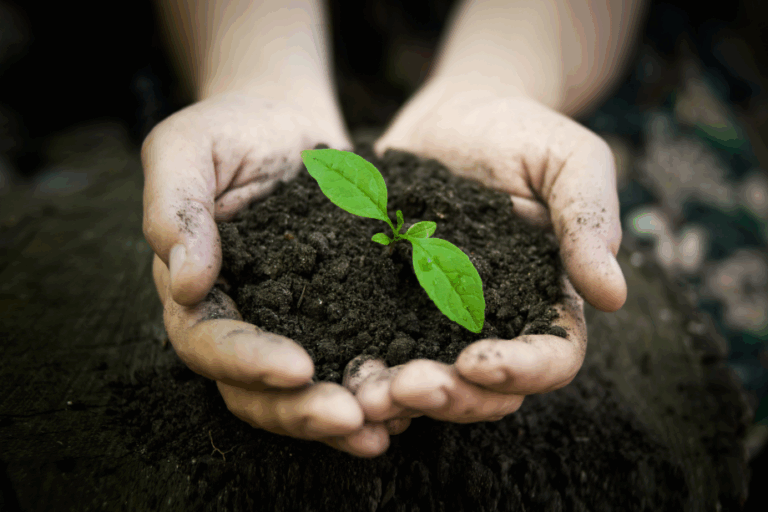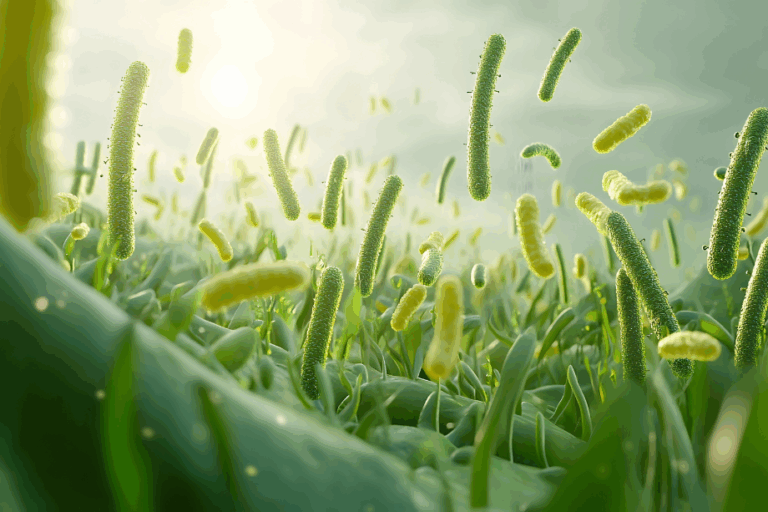Eating dirt has become a recent health fad amongst some people who are concerned about improving their gut microbiome. Dirt? Yes, dirt! But does it really confer benefits for the gut and overall health? And should we literally be eating spoonfuls of the stuff? Let’s dig a bit deeper (into the dirt!) to learn more.
While eating dirt (or geophagia) is considered by some to be a new and maybe even ridiculous “fad”, it’s a practice that has actually been around for thousands of years and has possibly helped the human race survive throughout millennia. Just about every culture has put eating dirt into practice, and while the motivations may vary, the benefits are universal: healthier people.
Hippocrates writes of geophagia in his medical textbook linking “earth eating” and anemia. A few hundred years later, alica, a porridge that contained red clay was used as a remedy for mouth ulcers, hemorrhoids, and diarrhea. South American tribes in the 18th and 19th centuries consumed dried earth in “considerable amounts” during periods of famine. Today, geophagia is an integral part of social and cultural life in children and young women of reproductive age in Luoland, Kenya. Clay eating in pregnant women is probably one of the most widely documented accounts of geophagia and is still a common practice in the southern U.S.
While some believe earth eating to be a practice of disordered eating (called pica), scholars believe quite the opposite – it is one of our earliest examples of humans using the earth to treat medical conditions. But in what capacity does dirt offer medicinal aid? A 2011 study investigated the three leading hypotheses on why people throughout history eat the earth: 1). To satisfy hunger during famine, 2). To act as a mineral supplement for those who are deficient, and 3). To protect against parasites, pathogens, and toxins. Based on all data collected, the first two hypotheses were deemed unlikely, and the third, the most probable – dirt is most often consumed in vulnerable stages of life (childhood and during pregnancy) when pathogens and parasites are a greater threat. In addition, geophagia is most often practiced in tropical climates where parasites and foodborne pathogens are much more common.
So what exactly makes dirt so “protective” and good for us? Modern research has uncovered that dirt contains what the scientific literature refers to as soil based organisms (or SBOs). These organisms, including bacteria and other microbes, are the very things that make plants thrive and are responsible for the same vital functions in the soil that our microbes carry out in our guts; they metabolize plant material, synthesize vitamins, fight against pathogens, and much, much more. Not only do these organisms work wonders in the dirt, but they also make their way into our own digestive tracts, by way of our hands and raw fruits and vegetables. They do some important jobs there too, like helping to synthesize vitamins, antioxidants, and enzymes. Once rooted in our guts, these beneficial organisms help crowd out pathogenic bacteria and other harmful microbes, and play a role in reducing inflammation and regulating the immune system. In short, like all beneficial bacteria, SBOs play an integral role in keeping the gut microbiome balanced.
Let’s take a look at the scientific research supporting dirt exposure and consumption as an integral part of thriving human health. First, occupations and hobbies that involve exposure to dirt have an overwhelming body of evidence supporting their health benefits. Studies show that occupations like farming and activities like gardening and hiking improve mood and symptoms of anxiety and depression, and can decrease dementia and Alzheimer’s risk. These activities have also been found to reduce stress, decrease chronic disease rates, and lower your likelihood of dying from cancer, heart disease, or diabetes.
Second, the wide range of scientific studies conducted on SBOs show positive results in using these beneficial bacteria strains to improve gut and immune related conditions, such as allergies, asthma, digestive upset (including gas, nausea, and indigestion), irritable bowel syndrome, autoimmunity, and gut inflammation.
As Dr. Chutkan discusses in her book, The Microbiome Solution, probably one of the biggest mistakes our modern society has made in looking after our health is over sanitization – from hand sanitizers to disinfectant cleaners; concrete jungles to pesticide-ridden, sterilized foods – we are washing away the very thing that makes us thrive… dirt! Studies show that families who have a dog have less allergies, mothers who vacuum their houses less have healthier babies, less industrialized countries experience lower rates of non-communicable diseases, and so on. The more exposure we have to dirt and the natural world, the more diverse our microbiomes and the healthier we are.
So does this mean we should head out back and start shoveling dirt into our mouths? Not exactly! For one, depending on where you live, the dirt in your backyard could be filled with chemicals and other undesirable ingredients that wouldn’t do much for your microbiome or your overall health and may even be harmful to you if ingested. And second, there are other, more subtle (and palatable) ways to consume dirt on a daily basis. Here are some tips on consuming more dirt in your daily life:
- Spend time outside. According to the Environmental Protection Agency (EPA), adults spend 93% of their lives indoor (87% inside and 6% in automobiles), and only 7% of their entire lives are spent outside. So, for many of us, the first step to getting dirty is simply spending more time outside. And when you are indoors or in your car, open your windows for more outdoor exposure. While this isn’t directly consuming dirt, just being outside will expose your skin and clothing to organic matter that can eventually make its way inside you.
- Touch dirt. Simple, right? When is the last time you actually touched dirt? For many of us, it’s been quite some time. Two ways to accomplish this are to start a garden and to walk barefoot. Both are simple activities that expose your bare skin to the earth. And these two actions alone hold a body of evidence in promoting a reduction in stress related markers and even in prolonging life.
- Get a dog. As mentioned above, dogs confer a myriad of health benefits and are an indirect way to bringing more dirt into a home (and into our guts!). Dogs also encourage more outdoor time with walks and other dog-friendly outdoor activities…which means more exposure to dirt. If you’ve been considering a dog, now’s your time to get one!
- Consume organic, raw, and lightly rinsed vegetables and fruits. While conventional produce needs more scrubbing to wash away harmful pesticides, organic and biodynamically grown foods can be lightly rinsed with just water. When choosing your produce, find organic vegetables and fruits that are visibly dirty with the roots still attached. Before consuming, lightly rinse the dirt away and don’t be afraid to consume remnants of the soil along with your raw produce. Eating raw vegetables and fruits daily is also important, as the process of cooking degrades and kills SBOs. And don’t just stick to your local grocery store; shopping at your local farmer’s market or picking produce directly from the farm are great ways to increase your exposure to a wide array of microbes.
- Eat fermented foods. Fermented foods contain SBOs and are rich in both prebiotic and probiotic bacteria. Consuming fermented foods daily is one of the best and easiest ways to expose your gut to a diverse array of microbes. Here are some great fermented recipes to get you started: Gingered Carrots, Coconut Milk Kefir, and Garlic Dill Pickles.
- Stop sanitizing your hands… and your body. One of the main ways dirt and other organic microbes make their way into our digestive tracts is through our hands. If we are constantly scrubbing ourselves with hand sanitizer and soaps, our guts have no chance of benefiting from these incredible critters. While washing hands and bathing are important, especially during cold and flu season, a little regular soap and water can go a long way.
(For more Live Dirty tips, check out Dr. Chutkan’s’ book, The Microbiome Solution for a complete list of Live Dirty Do’s & Don’ts.)
And what about eating actual dirt? While the dirt in your backyard may not be the best choice, there is a specific kind of earth that is. It’s called shilajit (or mineral pitch), which is the result of the slow breakdown of plant materials by microorganisms over centuries. Shilajit is found in the Himalayas and is now an available dietary supplement worldwide in many forms, including resin, liquid, extract, and powder form. Rich in 85 minerals, it has been used in scientific research to treat a large assortment of diseases and conditions, including in the areas of heart health, obesity, male fertility, liver cancer, chronic fatigue syndrome, viral infections, anemia, longevity, and anti-aging. Primarily though, shilajit and it’s most active ingredient, fulvic acid, show possible medical applications for slowing cognitive aging. While shilajit contains some scientific backing, more clinical trials are needed to confirm dosage and efficacy.
Those who should not take shilajit include those younger than 3 years of age and those with a current infection, serious heart or high blood pressure issue, or chronically high blood iron levels. Keep in mind that the shilajit available on the market is a processed dietary supplement that may not have been tested for safety or efficacy. Instead of a supplement, incorporating prebiotic and probiotic-rich foods and outdoor activities into your daily life is our recommendation at Gutbliss. Live Dirty!







